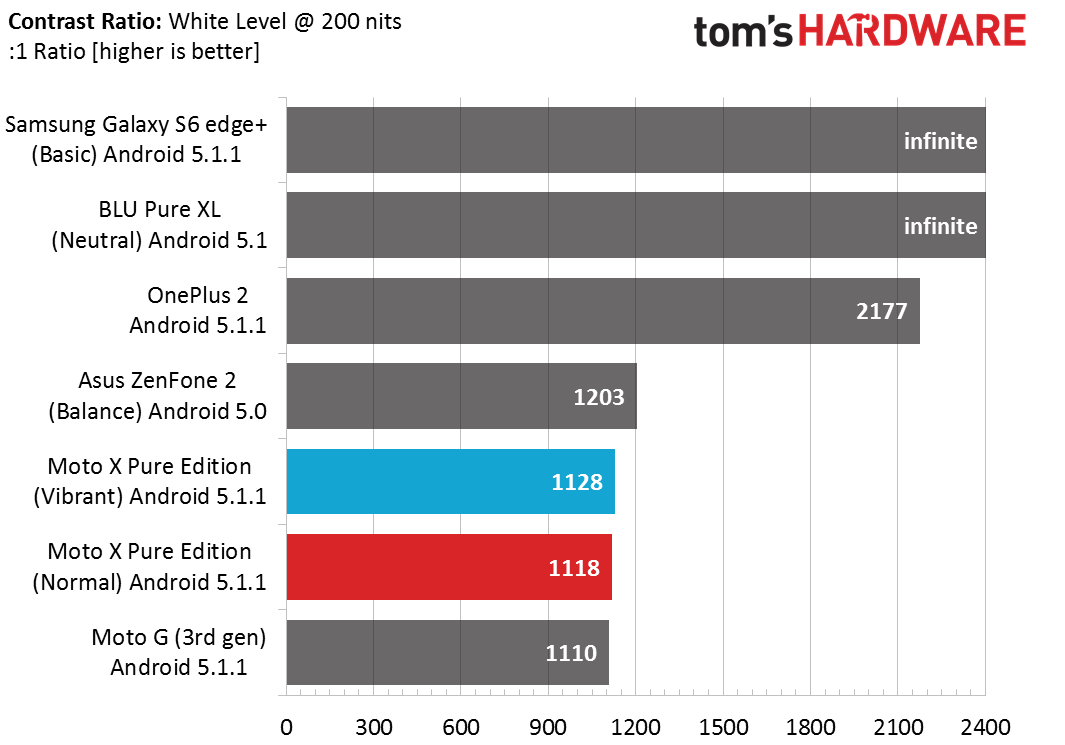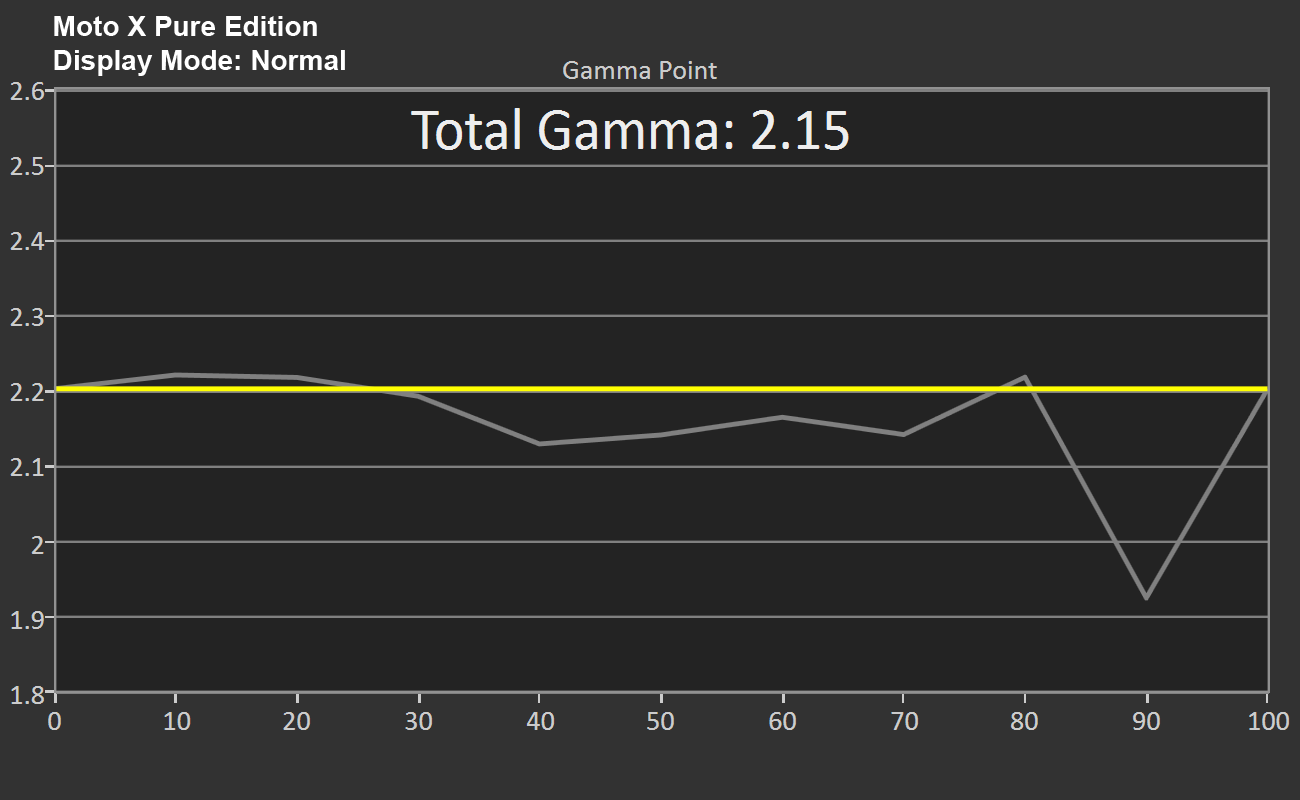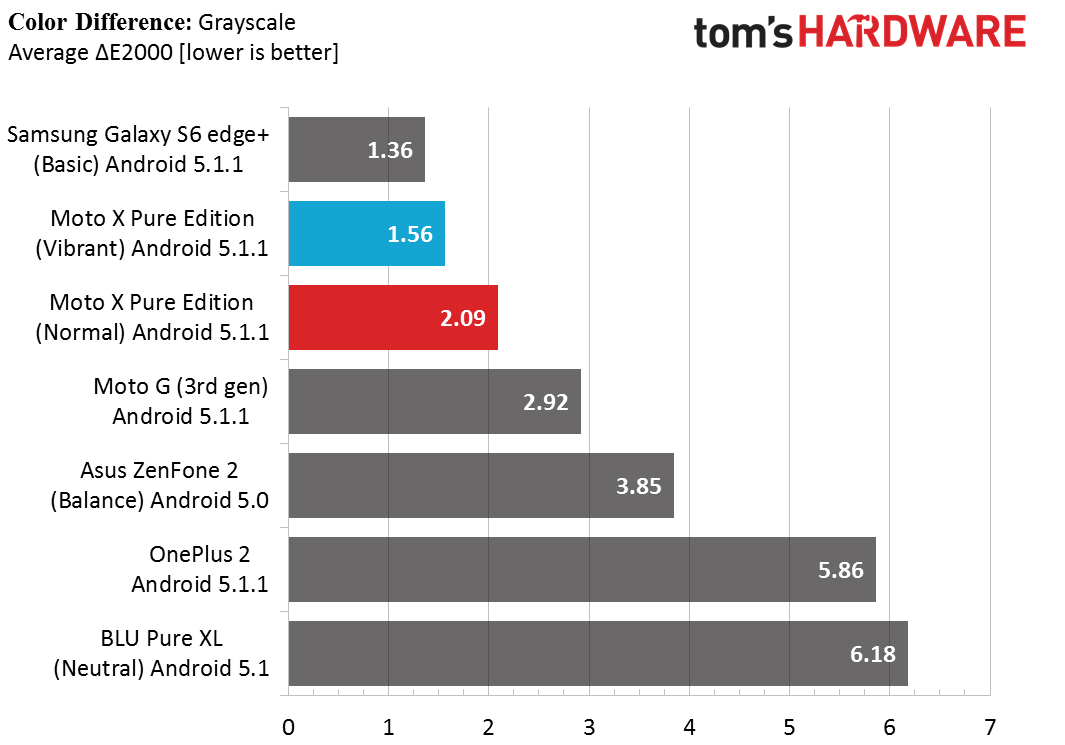Motorola Moto X Pure Edition Review
The Moto X Pure Edition’s software is purely Android, its attractive styling is purely Motorola, and its customization options make it purely yours.
Why you can trust Tom's Hardware
Display And Audio
Motorola pushes the Moto X Pure Edition into phablet territory by bumping screen size up from 5.2-inches in the Moto X (2nd gen) to 5.7-inches. Screen resolution also increases from FHD (1920x1080) to QHD (2560x1440), giving the new, larger display a pixel density of 520 PPI.
The Pure Edition also ditches the AMOLED panel used in the previous generation, replacing it with an IPS LCD. AMOLED panels use less power in low APL (Average Picture Level) conditions and have superior black levels relative to IPS panels; however, IPS panels are generally brighter than AMOLED and are more power efficient in high APL conditions (think mostly white backgrounds). Both technologies can yield excellent results, but the change is a little curious considering that Moto Display is one of Motorola’s signature features. Since an AMOLED display turns on only the necessary pixels (displaying black requires no power), it will use less power than an IPS display that needs to turn on the entire backlight even though Moto Display lights a small fraction of the total pixels. This change could be just a cost or panel supply issue, but it’s more likely that IPS’ better efficiency at higher APL conditions, which are prevalent throughout Android and common apps, outweighs the power deficit relative to AMOLED when using Moto Display, resulting in a net gain in battery life. The Pure Edition’s new IPS display also supports panel self-refresh, which helps save more power by not updating the display when the content is static.
One positive trend we’re seeing more of lately are phones that offer different display modes, primarily affecting color temperature and saturation, that give users more control over how content appears on the screen. The Moto X Pure Edition offers two choices: Normal and Vibrant. We test both options and show the results in the charts and graphs below.
We’re using SpectraCal's CalMAN software and SpectraCal C6 colorimeter for display measurements. All of the charts below with a gray background were generated in CalMAN v5 Ultimate. If you would like to learn more about our display testing procedure, or gain a better understanding of how these measurements affect visual quality, please read our article about how we test mobile displays.



Display brightness ranges from seven nits to around 550 nits, an excellent value considering we have yet to see an IPS display break the 600 nit barrier. Samsung's SAMOLED panels exceed this value, but only in direct sunlight after engaging Auto overdrive mode.
The Pure Edition’s black level is also very good for an IPS display. Panels using photo-aligned crystals, like those used in the iPhone 6 and above or devices such as the OnePlus 2 and LG G4 that use JDI's IPS-NEO panels, achieve better black levels, but the Pure Edition’s level is low enough not to be an issue.



In Normal display mode, the Pure Edition tracks the ideal gamma value closely up to 80% luminance before falling off. While not ideal, it’s still very good and significantly better than the Asus ZenFone 2 and OnePlus 2, both of which suffer from poorly configured gamma curves. Similar to these two phones, the Pure Edition’s gamma curve in Vibrant mode is also too high across the full luminance range, resulting in a loss of shadow detail, muted highlights, and generally darker colors.
Get Tom's Hardware's best news and in-depth reviews, straight to your inbox.



The Pure Edition’s display falls very close to the target color temperature in both display modes. This is a pleasant surprise considering how bright the screen gets. To get brightness above 500 nits, most phones with IPS screens “cheat” by favoring blue output (backlights use blue LEDs) over red, resulting in a familiar blue cast from the cooler color temperature. In Vibrant mode, the color temperature varies a little more, skewing slightly warm below 50% luminance.


Motorola obviously put some effort into calibrating the Pure Edition’s display. Normal mode shows a little less red than blue and green, but no color channel varies by more than 4% from ideal. The Vibrant mode is perfect at 50% luminance, with a small 3% emphasis on red at lower values. Above the halfway point, the blue and green channels are up about 4%, while red is down 5%. Overall, these are excellent results.



Grayscale accuracy in both the Normal and Vibrant modes is excellent, with average ΔE2000 error falling between about 1.6 and 2.1, respectively. In Normal mode, grayscale error remains below three, where error is visible but acceptable, across the full luminance range and below two up to 50%. The Vibrant mode is even better, creeping up to three only above 90% luminance and remaining below one, which is basically imperceptible, across most of the luminance range. This is better than any other phone we’ve seen at this price point and is even better than most flagships.


The Pure Edition’s display does a great job covering the sRGB color space. In the ongoing spec wars, many companies are equipping their phones with wide-gamut displays and boasting about their superior color rendition. This marketing hype is misleading, however, because neither Android nor iOS support system-wide color management, and neither do any of the default apps. Until software support arrives, having a display that renders colors outside of the sRGB color space results only in oversaturated, inaccurate colors.


It’s in the color saturation sweep test that we see the true purpose of the Pure Edition’s Vibrant mode. In our discussion about color gamut above, we noted how displays that extend coverage beyond the sRGB color space show oversaturated colors. While we prefer a more natural look, some people prefer the more vibrant colors of a wide-gamut display. The Pure Edition’s Vibrant mode caters to this latter group, applying moderate color compression to boost color saturation.
The Pure Edition’s Normal mode focuses on color accuracy and performs well in the color saturation sweep. It hits every target box for each tested color, which is all we can ask for.





Another test and another excellent performance. The Pure Edition’s color accuracy in Normal mode is even better than the much more expensive Galaxy S6 edge+. Color ΔE2000 error remains below three for all the tested colors, and about half of them have an error below one, which is generally imperceptible. Even in Vibrant mode the Pure Edition is still better than other phones in its class. Intermediate colors show increased error due to the applied color compression, but with the exception of red, all of the primary and secondary colors are still at or below one.


Full Size Images: [Color Palette: Moto X Pure Edition Normal], [Color Palette: Moto X Pure Edition Vibrant]
The color palette above shows the target color on the bottom versus the displayed color on the top and is a nice way of visualizing the color error discussed above [note: the color accuracy of your screen will affect the actual colors you see]. The accuracy of the Pure Edition’s Normal mode is readily apparent; it’s difficult to see any differences between the displayed colors and the targets even when comparing them side by side. The grayscale values are also very close, with an almost unnoticeable green tint.
Looking at the color palette is the best way to see the effects of the Pure Edition’s Vibrant mode. Color compression does indeed make colors look more vibrant, but they fall short of the overly-saturated, neon-like colors from a wide-gamut display. The Vibrant mode’s gamma curve is also too high, making colors and grayscale shades appear too dark.
Overall, we’re really impressed with the Moto X Pure Edition’s display. It’s bright and clear, and Motorola’s meticulous calibration results in excellent looking colors. If color fidelity isn’t your thing, there’s even a mode that creates richer looking colors to catch your eye, while avoiding the unnatural saturation levels of wide-gamut displays. Of all the devices we’ve tested, the Pure Edition has the best looking screen in its price range.
Audio Performance
Unlike the previous two versions of the Moto X, the Pure Edition has front-facing stereo speakers, similar to Motorola’s Nexus 6. The stereo speakers definitely create a wider soundstage, and with the speakers facing the front, you do not have to set the phone on a table or cup your hand awkwardly behind the phone to get the best sound.
The external speakers sound pretty good. They’re still small phone speakers, so there’s almost no bass. Kick drums are anemic and low-frequency thumps are MIA in hip-hop. The lack of low-end also makes male vocals sound a bit hollow. While music sounds overly bright, it does remain clear. Even in complex music it’s possible to pick out individual instruments.
The speakers also get plenty loud, although they are not the loudest we’ve heard—the Nexus 6 is louder. The Pure Edition’s amplifiers, like most used in smartphones, reduce distortion at high volume levels by limiting current and voltage. This works very well, with minimal distortion at max volume.
Plugging in a set of headphones nets a pleasant music listening experience. At first, I could not hear a difference between the Pure Edition and our iPhone 6 reference. Listening more closely, however, revealed some very subtle differences. Low-end notes were just a bit softer from the Pure Edition and individual sounds were not quite as distinct. Notes in quick succession also tend to run together. For example, listening to a harp in the background with the iPhone 6, I could hear all four string plucks, but I could only make out two when listening to the same song on the Pure Edition. Again, these differences were very subtle were very subtle and probably would go unnoticed without doing a side-by-side comparison.
-
ummduh ReplyWow! It took you a while to get your hands on a Moto X PE.
No kidding! I've been looking for info on the next version of this thing already!
-
abbadon_34 I love the Star Wars / Star Trek reboot analogies, I've been struggling to find a way to described them, and this is perfect!Reply -
abbadon_34 Shouldn't the battery test show how long it take to RECHARGE the battery? With standard 1A and QC chargers, simple graph, or just 50%, 90% 100%Reply -
bluelady1960 I have this phone ....now...I love everything about it but..the battery would get hot ..make sure that you turn on the cooler .I used Motorola product c in the TV business for years ...damm fine products...Reply -
amk-aka-Phantom You forgot to mention that this phone doesn't support Camera2 API, and that SUCKS. Stock Moto Camera is garbage, barely anything is adjustable manually. Also, LG G4 can shoot 1080p60 videos with the same SoC while this thing can't. (2160p30, 1080p30 or slo-mo 720p120 played in 30 fps)Reply
Disregard all battery life tests, all you need to know is that this phone dies after 3-4 hours of browsing on Wi-Fi, not gaming. Turbo Charging offsets that to an extent, but it annoys me because more charging cycles = shortened battery lifespan. BTW @abbadon_34: about 1 hour 15 minutes from 5 to 100% and 30 minutes from 5 to 50% on bundled Turbo charger; I used a normal 5 V charger a few times but didn't record how long it took :(
Still love this phone though. There might be worthy alternatives this year but I was looking for Qualcomm SoC (so I can get CyanogenMod later - which, annoyingly, is still not there fully), decent camera, stock Android, large and at least FHD display and full support for less-than-obvious features such as USB OTG (works fine) and Miracast (works great, who even needs Chromecast?), and all that for a reasonable price. And on that front, this phone delivers like no other. Ideally, though, I'd rather it have FHD AMOLED, larger battery (like on Moto X Force - I think it's known as Droid Turbo 2 or something in the US, the one with shatterproof display) and full support for Camera2 (and 1080p60 recording, since both the SoC and the sensor can do it). Not inflating the price just for lulz in some regions would also be greatly appreciated... -
Kamen Rider Blade I've had the Moto X Pure Edition since launch. It's an awesome phone. Especially considering that I went from a Google Galaxy Nexus -> Moto X Pure Edition. It's definitely best to get the phone that you want.Reply -
NeatOman I wanted to get the Moto X Pure but i really wanted to wait for a new generation of SoC's and the 820 seems to be it. I think I'm going to get the LG G5 after having only Nexus phones for the last 3 1/2 years (Nexus 4, Nexus 5.. still).Reply